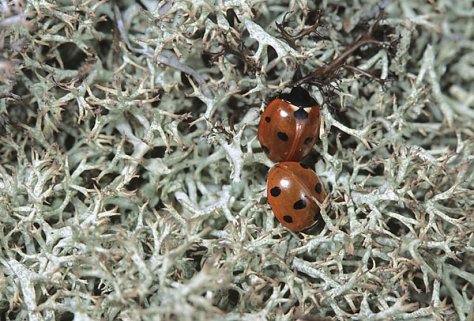Looking at the doings of ladybirds
Photos: Urmas Tartes
Translation: Liis
Seven-spot ladybirds emerging from lichens in spring
Seven-spot ladybird Seitsetäpp-lepatriinu
There is no need to tell anyone what the ladybird looks like. They overwintered in moss or withered leaves as full-grown beetles. The spring-time diet consisted of plant nectar and at the same time they also searched for a mate, to sustain the ladybug tribe.
The little bunches of eggs were laid by the ladybug „mom“ near greenfly colonies so that the newly hatched beings would have a ready-laid dinner table. But how does she know that there are any aphids at all on these trees or plants? She has of course made thorough explorations in advance but sometimes she too may be wrong. The number of eggs depends on the weather as well as the abundance of food, they may be from a few hundred to thousands, sometimes even more, during a period of three moths. The eggs are abut one millimetre long, with an oblong shape.
After hatching the larva eats its own shell and then sets out to find its main food, aphids. Up to a month is spent in the larval stage (see Urmas’s photo below). During that time these favourites of gardeners greedily destroy a considerable number of aphids – a hundred aphids or three hundred larvae per day.
After this the larva pupates, and after a couple of weeks a young seven-spot ladybird emerges from the pupa. It is still pale yellow in colour then, and the looks familiar to us appears in a few days, but this too depends on exterior factors. Thus becoming a ladybird takes more than a month, and in a warm summer two generations of ladybirds see the light of the day.
Ladybird larva
As one ladybird beetle can destroy some thousand aphids during its lifetime they have been cultivated in Central European countries for marketing to gardeners. There is no need to fear that the ladybugs will slip away as long as there are enough aphids. In Estonia too ladybirds have been collected to get them to settle in one’s own garden – but only when no insecticides are used in the garden!
In addition to the seven-spot ladybird we also have five-spot and two-spot ladybirds. The bright red colour tells insectivores “we are not edible“. Who attacks gets a dose of evil-smelling and -tasting orange and corrosive hemolymph – after that it will be known that ladybirds are best left alone.










